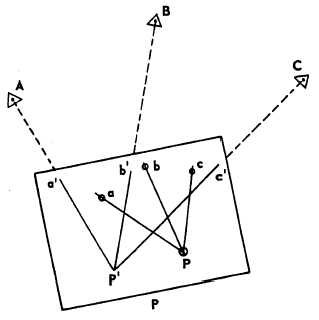will locate the desired point, P. This intersection is
used to orient the plane table. A check on a fourth
location will prove the location.
TRACING-CLOTH METHOD.— Another
method you can use to plot the location of an unknown
point from three known points is the tracing-cloth
method of resection. Figure 9-6 illustrates this
method.
In the figure, points a, b, and c are the plotted
positions of three corresponding known stations (A, B,
and C). P is the point of unknown location over which
the plane table is set. To plot the location of P you
first place a piece of tracing paper (or clear plastic)
over the map and select any convenient point on the
paper as P’. Then you draw rays from P’ toward the
three known stations. Next, you loosen the tracing
paper and shift it until the three rays pass through the
corresponding plotted points a, b, and c. The
intersection of the rays marks the location of P, which
can be pricked through the tracing paper to locate the
point on the map.
POINT LOCATION
The horizontal location of points can be
determined by triangulation using the plane table. Any
two points plotted on the plane-table sheet can act as
a base for triangulation. A ray drawn from each of
these points to some unknown point will form a
triangle, with the distance between the two known
Figure 9-6.-Tracing-cloth method of resection.
plotted points as the third side. The newly plotted
position of the third point will be at the intersection of
the rays. The rays to the unknown point maybe drawn
while occupying the known stations. This is called
intersection. The rays also may be drawn while
occupying the unknown point, and this is known as
resection.
Resection
The methods of resection were explained in the
discussion of plane-table orientation. As you know,
when using resection methods it is unnecessary to
occupy known stations. While resection can be used
with two known points, you should use mom than two
points to determine the location of a point to a higher
degree of precision.
Intersection
Intersection is accomplished by setting up and
orienting the plane table at each of two or more known
stations in turn. At each station, the alidade is pointed
toward the unknown point, and a ray is drawn from
the plotted position of the occupied station toward the
point being plotted. As such rays are drawn from two
or more stations, their point of intersection is the
plotted position of the required station. Two points are
the minimum requirement to establish a location. For
more accuracy, however, you should occupy three or
more points.
Radiation
In plane-table surveys when intersection is used,
a series of radiating rays are drawn and marked. These
rays all radiate from known stations. Points are located
by drawing rays from one or more known stations. The
intersection of the rays determines the plotted location
of the desired points. When drawing rays, be sure to
identify clearly the object that each ray is being drawn
to. This is important since an object viewed from one
direction may appear differently when viewed from
another direction. This can lead to rays being drawn
to the wrong object which will result in errors in
plotting point locations.
Progression
Progression, or plane-table traverse, starts from
a known position and uses a continuous series of
9-5

